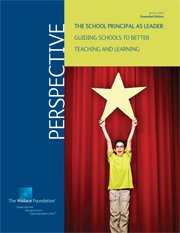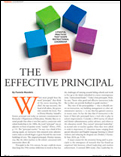The Principal Story Learning Guide
To advance the professional learning of aspiring and current school leaders

Unit 4: Improving instruction
Purpose: Unit 4 provides participants with an opportunity to identify actions essential to improving teaching and learning. Follow the links below to move through the sections of this unit. Approximate Time: 4.5 – 5.5 hours.
Facilitators: Adult learning professionals may use this web-based learning tool in principal preparation courses or in workplace study sessions. Facilitators may encourage participants to take advantage of the writable PDFs to record and save their responses. For onsite study groups or classes, the facilitator may choose to print relevant worksheets and provide them to participants. Depending on class structure and learning goals, facilitators will use these tools to provide group and individual learning experiences within the following structure:
| Consider ideas and connect with others | |
| Watch the film clip | |
| Read the excerpt | |
| Complete the activities |
Consider ideas and connect with others
Think about the role of a school principal in improving instruction. Independently, respond to questions on the worksheet and exchange responses with a partner. Connect with others, if applicable, to discuss common themes.
- What does it mean for principals to improve instruction for all students?
- What systems do you believe must be in place for teacher teams to learn?
- What examples or indicators of improving instruction can you share from your own experience?
Watch the film clip
View a clip on improving instruction to see research in practice. Use the Big ideas chart to guide independent note-taking while viewing.
In this clip, viewers observe principals Tresa Dunbar (Nash Elementary School) and Kerry Purcell (Harvard Park) monitoring teacher and student progress. The principals work directly with teachers on ways to improve instruction. [Time: 6 minutes, 14 seconds]
Read the excerpt
The School Principal as Leader: Guiding Schools to Better Teaching and Learning (The Wallace Foundation, 2013), 11;14.
Download excerpt in PDF format.
Effective principals work relentlessly to improve achievement by focusing on the quality of instruction. They help define and promote high expectations; they attack teacher isolation and fragmented effort; and they connect directly with teachers and the classroom, University of Washington researchers found.1
Effective principals also encourage continual professional development. They emphasize research-based strategies to improve teaching and learning and initiate discussions about instructional approaches, both in teams and with individual teachers. They pursue these strategies despite the preference of many teachers to be left alone.2
In practice this all means that leaders must become intimately familiar with the “technical core” of schooling — what is required to improve the quality of teaching and learning.3
Principals themselves agree almost unanimously on the importance of several specific practices, according to one survey, including keeping track of teachers’ professional development needs and monitoring teachers’ work in the classroom (83 percent).4 Whether they call it formal evaluation, classroom visits or learning walks, principals intent on promoting growth in both students and adults spend time in classrooms (or ensure that someone who’s qualified does), observing and commenting on what’s working well and what is not. Moreover, they shift the pattern of the annual evaluation cycle to one of ongoing and informal interactions with teachers.
The Minnesota-Toronto study paints a picture of strong and weak instructional
leadership.
Both high- and low-scoring principals said that they frequently visit classrooms and are ‘very visible,’ ” the researchers write. “However, differences between principals in the two groups come into sharp focus as they describe their reasons for making classroom visits. High-scoring principals frequently observed classroom instruction for short periods of time, making 20 to 60 observations a week, and most of the observations were spontaneous. Their visits enabled them to make formative observations that were clearly about learning and professional growth, coupled with direct and immediate feedback. High-scoring principals believed that every teacher, whether a first-year teacher or a veteran, can learn and grow.
… In contrast, low-scoring principals described a very different approach to observations. Their informal visits or observations in classrooms were usually not for instructional purposes. Even informal observations were often planned in advance so that teachers knew when the principal would be stopping by. The most damaging finding became clear in reports from teachers in buildings with low-scoring principals who said they received little or no feedback after informal observations.5
It is important to note that instructional leadership tends to be much weaker in middle and high schools than in elementary schools.6 Unlike their elementary school counterparts, secondary school principals cannot be expected to have expertise in all the subject areas their schools cover, so their ability to offer guidance on instruction is more limited. The problem is that those who are in a position to offer instructional leadership – department chairs – often are not called on to do so. One suggestion is that the department head’s job “should be radically redefined” so whoever holds the post is “regarded, institutionally, as a central resource for improving instruction in middle and high schools.”7
As noted above, a central part of being a great leader is cultivating leadership in others. The learning-focused principal is intent on helping teachers improve their practice either directly or with the aid of school leaders like department chairs and other teaching experts.
Complete the activities
Working in small groups or at their own pace, learners observe, discuss, engage, and reflect on the ideas and information presented in the film clips and related materials. Follow these links to tools that include writable PDF files to support this work.
| Activity 1: Discover personal assumptions | |
| Activity 2: Review research | |
| Activity 3: Link research with practice | |
| Activity 4: Take action | |
| Activity 5: Reflect |
Footnotes
1. Portin, Knapp et al., v.
2. Karen Seashore Louis, Kenneth Leithwood, Kyla L. Wahlstrom and Stephen E. Anderson, Learning From Leadership: Investigating the Links to Improved Student Learning: Final Report of Research Findings, University of Minnesota and University of Toronto, 2010, 78.
3. Kenneth Leithwood, Karen Seashore Louis, Stephen Anderson, Kyla Wahlstrom, Review of Research: How Leadership Influences Student Learning, University of Minnesota and University of Toronto, 2004, 24.
4. Seashore Louis, Leithwood et al., 71.
5. Seashore Louis, Leithwood et al., 86.
6. Seashore Louis, Leithwood et al., 87-90.
7. Seashore Louis, Leithwood et al., 92.
About
The Principal Story Learning Guide
Required Text
The Wallace Foundation. (2013). The school principal as leader: Guiding schools to better teaching and learning. New York: Author.
Optional Texts
Mendels, P. (2012, February). The effective principal. JSD, 33(1), 54-58.
Seashore-Louis, K., Leithwood, K., Wahlstrom, K., & Anderson, S.E. (2010). Learning from Leadership: Investigating the Links to Improved Student Learning. New York: The Wallace Foundation.
THE PRINCIPAL STORY
Offered in
collaboration with:





